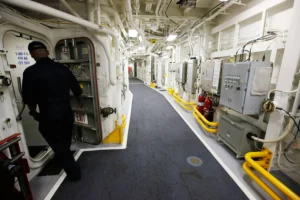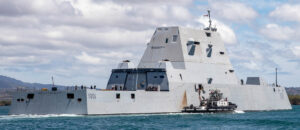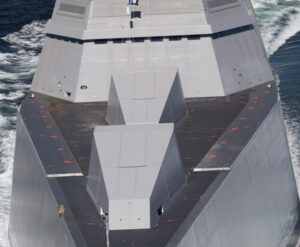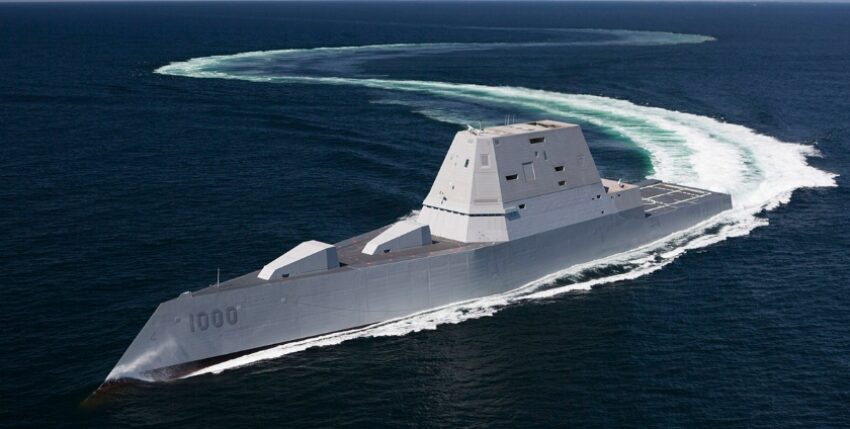Despite their high level of technical development, the futuristic-looking ZUMWALT-class destroyers have been criticised in the American media for years. Now the U.S. Navy is daring to make a new start.
The end of the Cold War and the collapse of the Soviet Union heralded a period of unchallenged dominance on the world's oceans for the U.S. Navy, in which conflicts with equal opponents on the high seas seemed rather unlikely. The tasks of the naval forces in providing fire support to forces operating on land, however, remained unchanged, as demonstrated by the deployment of IOWA-class battleships in the 1991 Gulf War. However, the decommissioning of the last IOWA battleship in March 1992 left the US Navy with a serious capability gap, which was to be closed by the "Land Attack Destroyer Programme" (also known as "DD-21"). This programme resulted in the ZUMWALT-class destroyers with their numerous innovations, which were to catapult maritime shipbuilding in the USA into the 21st century.
Capital ship for the 21st century
The procurement project, known in the US Navy as the "DDG-1000 Program" since April 2006, resulted in a design with a displacement of 15,900 tonnes, a length of almost 190 m and a striking "tumblehome" design, in which the hull tapers upwards from the waterline. In combination with a special surface coating, this design reduces the radar cross-section of the ships to just 2% of the value of the smaller ARLEIGH BURKE destroyers. The rather futuristic hull with an inverted bow section was initially viewed with great suspicion from a stability point of view, but was soon able to prove its seaworthiness.
The ZUMWALT class also broke new ground in terms of armament. It was equipped with 20 Mk 57 VLS modules, each with four cells, which can fire either RIM-162 ESSM and RIM-174 ERAM for air defence, RUM-139 VL-ASROC for anti-submarine defence or BGM-109 Tomahawk cruise missiles. To engage land targets, two 155 mm AGS (Advanced Gun System) guns in stealth design were also installed on the forecastle, which can fire GPS-guided precision ammunition (Long-Range Land Attack Projectile, LRLAP for short) against land targets up to 150 km away. In addition, there were two 30 mm Mk 46 GWS high-velocity guns against small close-range targets such as speedboats, an MH-60R helicopter for anti-submarine defence and up to three unmanned MQ-8B four-bladed helicopters (now decommissioned by the U.S. Navy) for reconnaissance, target acquisition and fire support.
The ZUMWALT destroyers also set new standards in terms of propulsion right from the start. Their Integrated Power System (IPS) based on two Rolls Royce MT-30 gas turbines (35.4 MW each) and two Rolls Royce RR-4500 generators (3.8 MW each) can generate a total output of 78 MW, which corresponds to the requirements of a small town and provides the ships with more than enough electrical energy. At a speed of 20 knots, a ZUMWALT destroyer has energy reserves of 58 MW and thus enough power for future energy-based weapon systems such as laser weapons and next-generation sensor systems. With all this, the ships can operate with a minimum crew of just 130, but in normal operation 147 crew members and 28 aircrew are planned - significantly fewer than on the smaller ARLEIGH BURKE-class destroyers (303 to 323 crew members).
Changing situation, exploding costs
The ZUMWALT-class type ship was commissioned on 15 October 2016, with the MICHAEL MONSOOR following three years later. However, the strategic situation on the world's oceans had long since changed, with an increasingly self-confident China with world power ambitions joining a resurgent Russia. From then on, the U.S. Navy was once again forced to strengthen its classic "blue water capabilities", which required more ARLEIGH BURKE destroyers rather than the ZUMWALT class with its coastal deployment focus. In addition to technical problems with the propulsion system and other components, the costs of the ZUMWALT programme had gotten hopelessly out of hand, rising from 1.34 billion dollars per ship to over eight billion dollars and robbing the U.S. Navy of urgently needed budget funds for other procurement projects. The class, originally designed for 32 units, was therefore gradually reduced to just three ships in favour of more ARLEIGH BURKE destroyers.

Photo: Michael Dwyer (AP)
However, the premature termination of the ZUMWALT programme caused the procurement costs for the precision ammunition for the AGS guns to skyrocket. While the cost of firing an LRLAP projectile was estimated at 35,000 dollars in 2004, by 2016 these costs had exploded to over 800,000 dollars - too much for a weapon system that was intended to provide massive fire support for forces operating on land. An alternatively usable BGM-109 Tomahawk cruise missile, for example, achieves a range up to 15 times greater with a 30 times greater payload at a cost of around 2 million dollars, depending on the variant.
As a result, no further orders were placed beyond the 150 LRLAP projectiles procured for test purposes in the 2014/2015 fiscal year, and the LRLAP concept was ultimately cancelled by the US Navy. Without ammunition for the distinctive AGS guns on the forecastle, however, the ZUMWALT class had also lost its ability to effectively and efficiently engage land targets, for which the procurement project had actually been initiated. The destroyer project, described in the American media as a "24 billion dollar nightmare", was now also threatening to become a conceptual disaster for the US Navy.
New weapons, new mission
However, the growing importance of long-range conventional hypersonic weapons (LRHW) for the U.S. Army heralded a long overdue change of course for the ZUMWALT class in 2022. One of the AGS guns on the forecastle, which had become pointless, was now to be replaced by launchers for Intermediate-Range Conventional Prompt Strike Missiles (IRCPS), which the ships can use against land targets over long distances. IRCPS missiles are also to be fitted in the larger Block V variants of the nuclear-powered VIRGINIA-class submarines and sustainably strengthen the deterrent potential of the US Navy against China and Russia. For example, China already has comparable YJ-21 missiles on its RENHAI destroyers, which can be deployed at more than six times the speed of sound against land and surface targets up to 1500 km away. Russia's navy has had a similar weapon system in its arsenal since 2022 with the 3M22 Zircon (NATO designation: SS-N-33).

IRCPS missiles reach six times the speed of sound and can be used against enemy command centres, air defence installations and other parts of the strategic infrastructure. The individual missile consists of a rocket booster that brings it to a predetermined altitude and position, from where a steerable - but unpowered - hypersonic glider (common hypersonic glide body; contains the warhead) heads for the target at supersonic speed. For the ZUMWALT class ships, four launchers for three IRCPS missiles each are planned in place of the forward AGS gun, meaning that each ship will have a total of twelve such missiles. However, the future role of the remaining AGS gun remains unclear for the time being.
The type ship of the class has already been converted by Ingalls Shipbuilding in Pascagoula, Mississippi, between August 2023 and December 2024. The third ship in the class, the LYNDON B. JOHNSON (keel laid in January 2017, launched in December 2018), was immediately completed without AGS guns to facilitate the installation of new weapon systems, which is why it will be the second unit to be equipped with IRCPS missiles; the older MICHAEL MONSOOR will follow at a later date.

Detailed tests of the weapon system are scheduled for 2027/2028. If these tests deliver the desired results, the ZUMWALT-class destroyers will have a range of capabilities by the end of the 2020s that will at least partially justify the enormous financial outlay for the ship class. In particular, the ships will also be given a new range of tasks from this point onwards, which, while still focussing on their effectiveness against land targets, will shift the focus from the previously planned operational-tactical level (direct fire support for ground forces near the coast) to the strategic level.
However, the potential of the ship class is not yet exhausted. The high performance of the IPS drive in particular makes the ZUMWALT destroyers ideal candidates for the installation of energy-intensive laser weapons, and plans already exist for the installation of two 600 KW lasers to combat small targets (drones, missiles, speedboats). Ultimately, the ships will probably mutate into (rather expensive) test platforms for new propulsion and weapon systems as well as modern sensor and stealth technology, forming a bridge between "old" and "new" naval forces and paving the way for the U.S. Navy to achieve maritime dominance in the 21st century.
Prof. Dr Christian Führer is head of the degree programme at the Baden-Württemberg Cooperative State University Mannheim.










